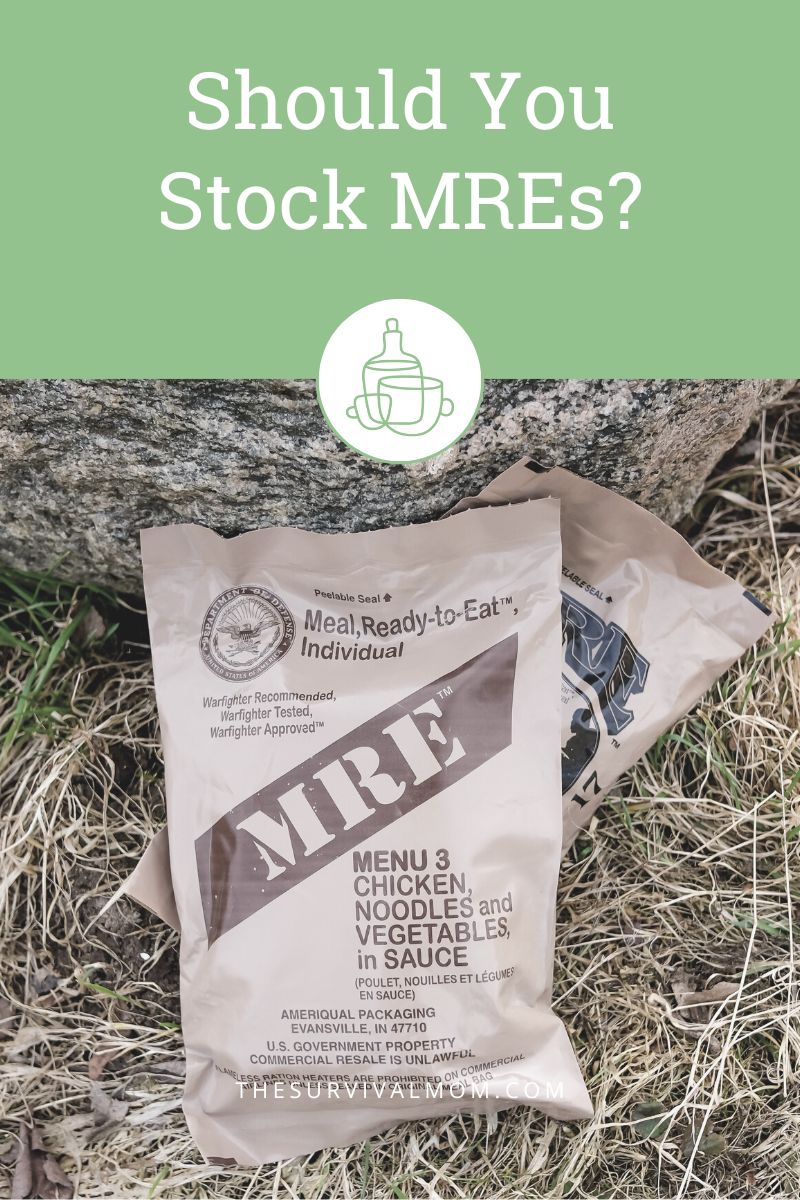Some of the links in this post may contain affiliate links for your convenience. As an Amazon associate I earn from qualifying purchases.
Meals Ready to Eat (MREs) seem to make it into the stockpiles, bug-out bags, and trunks of many preppers.
Yes, I have a few cases of them, too.
Unfortunately, few people do the leg work to understand MREs fully and whether they are a wise decision for themselves and their families.
In this article, we’ll discuss the information you should consider to determine whether to include these meals as part of your food storage and Emergency plans.

What is the purpose of MREs?
Let’s first talk about the source and purpose of MREs. Most of us are familiar with MREs as military food. The objective of the MRE is to fuel the troops and for that fuel to be 100% eaten and converted into energy.
Uncle Sam created them to fuel fighting soldiers in combat situations. The taste has to be decent enough to avoid revolt from the troops and to encourage them to eat the whole thing. If the forces aren’t eating, it wastes money, weight, volume, and, more importantly, calories/fuel.
Equally as important as what goes into MREs is what doesn’t get put into them. Uncle Sam does not want troops to have gas, loose stools, or lots of bathroom breaks on the battlefield. Therefore, you can expect a certain amount of constipation to be “built-in” to MREs. Ingredients are not added to increase constipation, but they definitely remove any items or contents that would encourage a regular or loose stool.
Emergency–food-storage-plan”>Why should I include them in my Emergency food storage plan?
Meals Ready to Eat are convenient, self-contained, and require no refrigeration. They include an entree, side dish, utensils, condiments, dessert, and napkin, plus pouches and flameless heaters for preparation. The flameless heater allows for on-the-spot cooking with no gas, electricity, pot, pans, or cooking utensils needed. It’s pretty slick, really.
As another layer of food security, they provide a backup to your backups for almost any Emergency or disaster, such as earthquakes, hurricanes, tornados, and so on. You get the picture.
How long can I survive on MREs?
MREs are only intended to be eaten for 21 days!
The military plan uses a plan of two per person per day, times 21 days, equaling 42 MREs. There are 12 in a case, which is almost four cases of MREs per person. These MRE stocking levels only account for half of your daily caloric need (more on this below), so you still need to augment this diet with at least one hot meal of regular food per day.
How long do MREs last?
While it can vary by brand, three years seems to be about the average advertised shelf life of MREs. Of course, just as with anything in your food storage, the food-storage/”>environment significantly affects the shelf life. They could last longer if kept out of direct sunlight in cool, dry temperatures. You’ll need to experiment to determine the best rotation schedule, which we’ll discuss next.
How many should I store?
We’ll calculate storage quantities and rotation schedules based on three things:
- the military plan of two per person per day
- the assumption that MREs have a shelf life of three years
- the assumption that you can eat them 21 days every year
Therefore, for each person, at any given time, you would stockpile 126 MREs, minimum. That’s 2 MREs per day, times 21 days, times three years. A case typically contains 12 meals, so that’s 10.5 cases per adult. To make the math easy, I’ll round that up to 12 cases per person.
How do I rotate them?
Using the above calculations, you’ll need to buy four new cases and use up four cases per year. This will result in maintaining the restocking rate and freshness.
However, the above figures are minimums.
Let’s assume we could go 21 days “on” MREs and then two or three or five months “off” MREs. And then again, return to another 21 days “on” again. Then you must stockpile twice as many MREs. And remember, you need to double your consumption to maintain proper rotation. This means four MREs a month must be eaten by each person.
Think carefully about your MRE stockpiles. If you’re going to buy them, be prepared to both buy and exhaust and equal annually. In our original calculation of 126 MREs per person per year, plan to purchase or restock a third of your supply each and every year.
Are there side effects to eating MREs?
Any person considering MREs for food storage should first understand the duration at which our bodies can tolerate them.
Eating an MRE-based diet is like going on any new diet. You are consuming food that your body is unfamiliar with processing. Anyone who has spent time on a diet will tell you that weird things can happen to their body. A change in stool, urine, digestion, energy, or appetite is not uncommon. MREs are no different. A person’s body is not accustomed to them and will revolt in some manner.
Keep in mind that these side effects are not necessarily unique to MREs. For example, you would probably encounter similar results if you switched to a 100% freeze-dried diet from a commercial manufacturer.
Are MREs all I need?
No. As a general rule of thumb, Uncle Sam tries to get the troops at least one hot meal daily. Guidelines like this imply that with 21 days of MREs, this isn’t the only thing the troops eat.
Troops in combat burn about 4,200 calories per day. Each MRE contains about 1,200 calories. The troops are issued two per day, assuming a hot breakfast and then MREs for lunch & dinner while out on patrols/maneuvers. This typically creates a negative caloric balance. Our military troops only eat about 2,400 – 3,600 calories per day but burn about 4,200 calories. As you can see by the numbers, this is not the ideal food pyramid or anywhere close! Check out this informative article about thefood-storage-calories/”> importance of calories and food storage.
MREs are simply survival food.
Can you eat them for more than 21 days and survive? Sure.
Should you? Probably not.
It’s much more economical to buy freeze-dried products in #10 cans, which have a shelf life of 10, 20, or 30+ years. In addition, freeze-dried products require less rotating, so there is less worry about eating them up before their expiration date. Read about The survival Mom’s food-storage-company/”>favorite company for freeze-dried food!
Are MREs a good choice for bug-out bags?
It’s not practical to use MREs in bug-out bags or when hiking. They’re heavy, bulky, and contain water.
Remember, these are designed for troops on short-term, lightweight patrol missions. The military will airdrop any extra-needed supplies and food they may need. Some preppers may not feel compelled to stock MREs. Look for lighter and possibly cheaper alternatives!
Also, take note if you are traveling on an airplane with MREs. They are not TSA-approved the way they are because the heating elements within them are banned from both checked and carry-on baggage. If you want to fly with your MRE, break it open, remove the individual packets, and take the heater element out.
Here’s how I store mine
Our food pantry has about 90 days of food and water for four people. In addition, we have one hundred #10 cans of foods per person (400 cans total). I am slowly working on tripling that amount. Lastly, we have 24 cases of MREs per person, which is 96 cases.
We annually refresh at 8 cases per person per year. So each person in our household has to exhaust eight MREs per month. To do this, we take them with us on vacations, cross-country trips during the holidays, on the boat, etc. We even give them away to friends and family. In the trunk of our car, we always keep about a half-dozen. If they go bad, we throw them away. Over time, we’ve noticed they don’t really spoil; they just seem to lose their nutrients.
Are they a good option for sharing with others in emergencies?
We keep twice as many MREs within our food storage as we should have. The reason is so that during an Emergency, we are prepared to help support family, friends, and neighbors. Unfortunately, our storage is not equipped, nor do I want to feed them for the long term. Instead, I’ll give them about six MREs per person and tell them to hike to safety or other friends. We can’t have them drain our pantry, but they can take the MREs as a gift and use it to get the heck outta dodge. They don’t have to go away empty-handed.
By my calculations, we could send as many as 36 people away with six MREs per person and still have 63 MREs per person for our family. We also have one hundred #10 cans of freeze-dried food, which should be enough to feed one person for a whole year. We have four people and store 400 cans of food. From our experiences, we’ve learned that about 100 cans fit beneath a king-sized bed.
Hopefully, this has been a beginning point for you as you consider MREs and the other types of foods you can store. Buy a case or two and try them out, noting how your body digests them and what meals you like. Then plan your MRE storage and rotation accordingly.
Do you store MREs?
Originally published May 13, 2017; updated by The survival Mom editors.
I’m the original survival Mom and for more than 11 years, I’ve been helping moms worry less and enjoy their homes and families more with my commonsense prepping advice.

